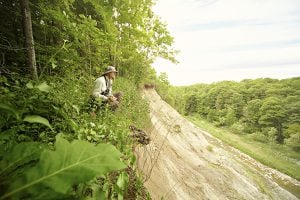
People & Culture
Survivor: The story of Phyllis Webstad and Orange Shirt Day
Phyllis Webstad turns her residential school experience into a powerful tool for reconciliation through Orange Shirt Day
- 1904 words
- 8 minutes
This article is over 5 years old and may contain outdated information.
Kids

Warbler birdsong and sunlight filtered down from the tree tops, mixing with the excited chatter of students as they spilled out of the woods and onto the rocky banks of the Mersey River. The Mill Falls rushed past them, its waters tinged a reddish-brown, and one student noted that the froth and colour made it look like a root beer float.
After the first leg of Canada’s Coolest School Trip, which they spent visiting some of Nova Scotia’s historic sites, the students of Allison Overbeeke’s Grade 8 class from Lethbridge Christian School in Alberta were ready to explore the province’s wilder side.
The annual contest, hosted by Canadian Geographic Education in partnership with Parks Canada, Historica Canada and the Canadian Wildlife Federation, asks Grade 8/Secondaire 2 students to create and promote a one-minute video about a Canadian national park and its natural or cultural significance. The Lethbridge students won with a video about Waterton Lakes National Park.
On the third day of their all-expenses-paid trip, the class took to the trails that wind through the Acadian woodlands and freshwater streams of Kejimkujik National Park and National Historic Site. Parks Canada guides greeted the students at the visitor centre and took them on a hike along the Mersey River, explaining its importance to the local Mi’kmaq.
This stunning natural landscape, which encompasses 426 square kilometres, is unique as a park because of its cultural heritage. The area contains evidence of about four millennia of Indigenous presence, with signs pointing to earlier peoples having travelled along the Mersey River as far back as 6,000 years ago. It was a site for seasonal camps, fish weirs, hunting territories, portage routes, and burial grounds.
The Kejimkujik area is known for its slate outcroppings, and over the centuries the Mi’kmaq carved more than 500 individual petroglyphs into the stone. These images, depicting things like traditional clothing and ocean-going canoes, provide invaluable insight into Mi’kmaq history and culture.
The name of the park itself is derived from the Mi’kmaq word kejimkuji’jk, which means “little fairies”; some of the petroglyphs found at Kejimkujik are thought to be representations of these mythical beings.
The students stopped at Mill Falls to break for lunch and to reflect on what they had learned. After a campfire barbecue and another short hike, they spent the afternoon learning about how the Mi’kmaq used birch bark for everything from shelters and canoes to baskets and moose bugles.
Next the students got to try their hand at using an atlatl, a tool for throwing darts and spears. The atlatl consists of a small piece of wood that serves as a launcher for a three-foot-long wooden dart, which has a notched end that lines up with the atlatl. The Mi’kmaq used this tool for hunting. After a demonstration, students were given the opportunity to launch darts, using stuffed animals as targets. (No stuffed animals were harmed in the learning process!)
The technique proved difficult to master. Lisa Beswitherick, 13, was among the few who were successful. “The most challenging part is holding onto two things at once then letting go of just one of them,” she explained.
The students then headed to the park’s oTENTik Village, where Parks Canada’s Learn to Camp staff showed them how to properly set up camp. For dinner, students made their own skewers to cook over the campfire.
Afterwards, they gathered on the sandy shore of Kedge Beach and watched the sunset over Kejimkujik Lake. At dusk, Ursula Johnson, a local Mi’kmaq artist, passed a traditional herbal tea around the campfire and told stories. As the last of the light faded from the horizon, stars filled up the sky and the students listened to a legend about two sisters who ended up falling between universes, between the stars and the earth.
Watch for tomorrow’s adventure log from Canada’s Coolest School Trip!
Are you passionate about Canadian geography?
You can support Canadian Geographic in 3 ways:

People & Culture
Phyllis Webstad turns her residential school experience into a powerful tool for reconciliation through Orange Shirt Day

Science & Tech
Celebrating Canadian Innovation Week 2023 by spotlighting the people and organizations designing a better future

Places
It’s an ambitious plan: take the traditional Parks Canada wilderness concept and plunk it in the country’s largest city. But can Toronto’s Rouge National Urban Park help balance city life with wildlife?

Kids
Highlights from day three of Canada’s Coolest School Trip